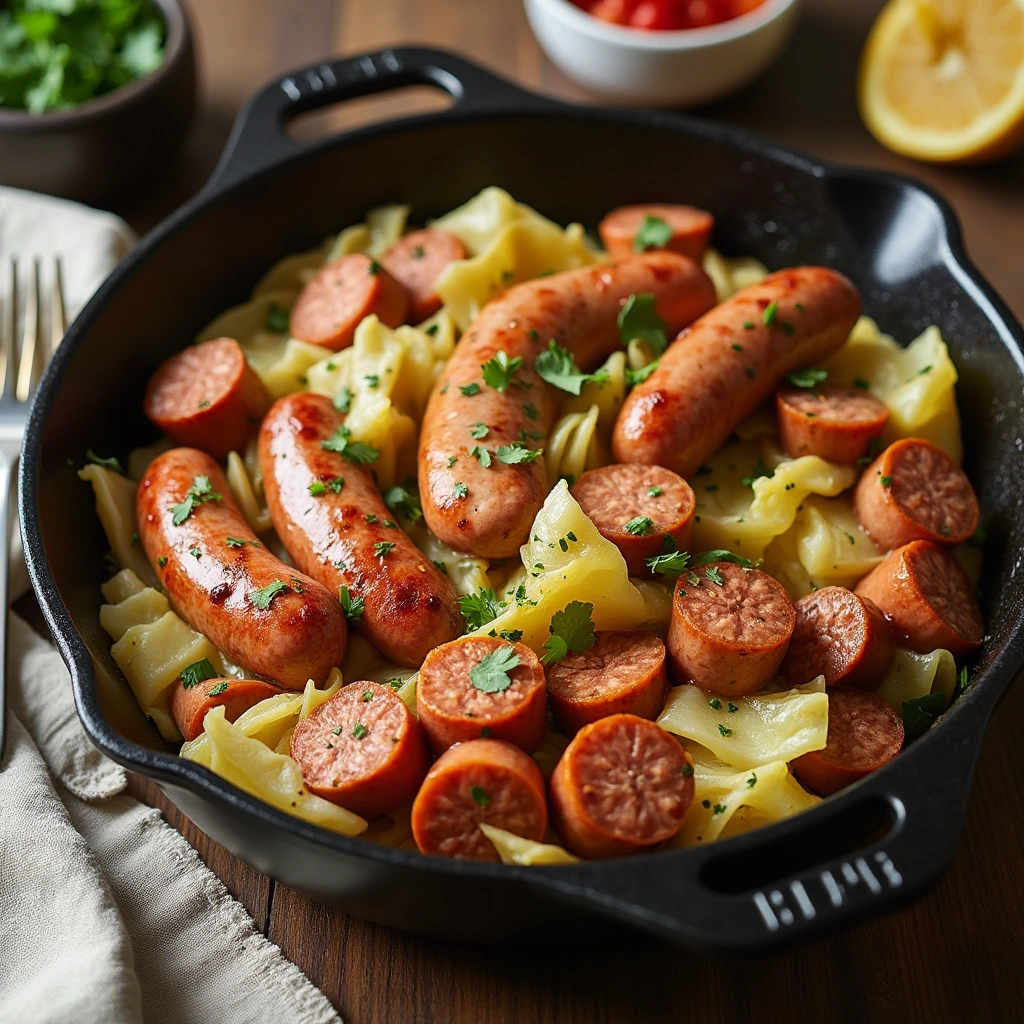As autumn’s cool air enters, the kitchen fills with the scent of sizzling sausage and tender cabbage. This dish is a beloved tradition, warming the soul and bringing back family memories. In just six steps, you can make this hearty meal, turning your kitchen into a cozy haven.
This sausage and cabbage recipe is perfect for both seasoned cooks and beginners. Its rich flavors and straightforward steps make it easy to prepare. You’ll create a meal that will impress your loved ones. Let’s explore the comforting world of sausage and cabbage together.
Introduction to Sausage and Cabbage
Sausage and cabbage dishes have been loved for centuries. They are comforting and budget-friendly, passed down through generations. These dishes, like cabbage rolls and pork and cabbage stew, are a favorite comfort food worldwide.
The Comfort of Traditional Meals
As the weather cools, the smell of sausage and cabbage fills homes. It brings back fond memories and the joy of family gatherings. This dish offers a sense of security and well-being, making it a favorite for many.
Why This Recipe Works
This recipe is simple yet versatile. It’s budget-friendly and can be tailored to taste. The sausage adds savory flavor, while cabbage adds crunch and nutrition. Together, they make a delicious and satisfying dish.
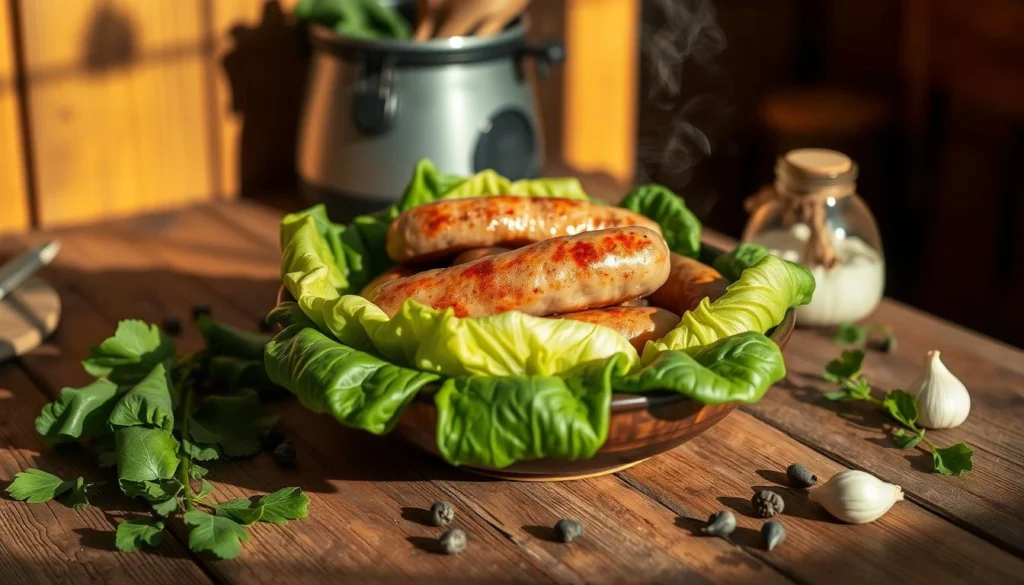
“Sausage and cabbage dishes are the ultimate comfort food, evoking memories of home-cooked meals and gathering with loved ones.”
Ingredients You’ll Need
To make a tasty sausage and cabbage dish, you need a few key ingredients. From the right sausage to fresh cabbage, let’s look at what makes a great meal.
Sausage Options
The sausage is the main star of this dish. You can pick from smoked sausage, Polish sausage, or kielbasa. Each sausage adds its own flavor, so try different ones to find your favorite.
Cabbage Varieties
- Green cabbage: A classic choice that offers a crisp texture and mild flavor.
- Red cabbage: For a pop of color and a slightly sweeter taste.
- Savoy cabbage: With its delicate, ruffled leaves, savoy cabbage adds a gentle sweetness.
Essential Seasonings
To make the sausage and cabbage taste even better, you’ll need some key seasonings. Salt, pepper, and garlic are a must. Adding caraway seeds or fennel seeds can also bring a unique flavor.
Optional Additions
- Onions: Diced onions can add a savory depth to the dish.
- Sauerkraut: For a tangy twist, consider adding a side of sauerkraut.
- Potatoes: Diced potatoes can make this a heartier, one-pot meal.
With these ingredients, you’re ready to make a delicious sausage and cabbage dish. It’s sure to satisfy your cravings.
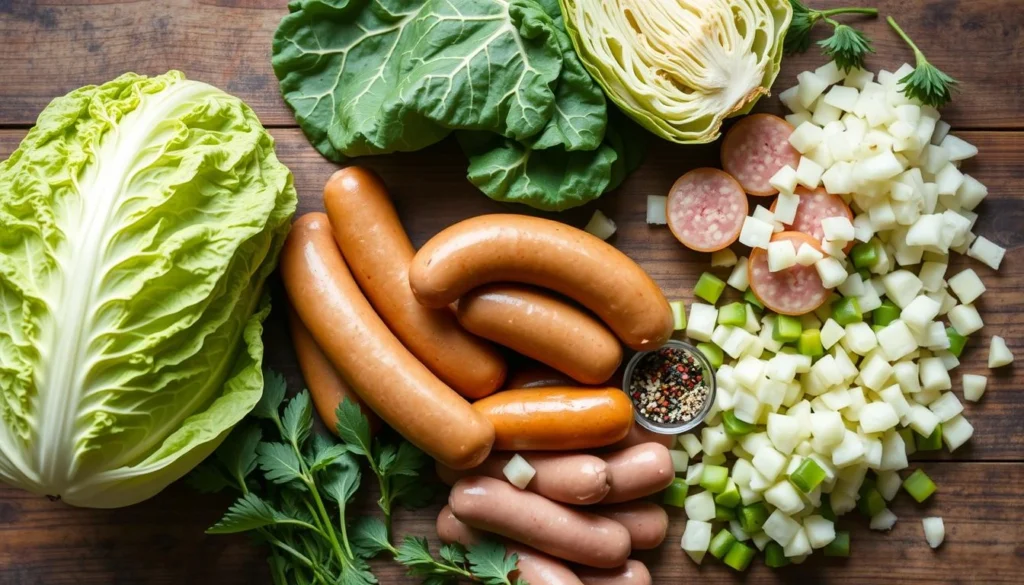
Preparation Steps
Getting ready for a perfect sausage and cabbage dish is all about the ingredients. Let’s look at the key steps to get your kitchen ready for this comforting meal.
Prepping the Cabbage
Start by picking a fresh, crisp cabbage head. Rinse it under cold water to get rid of dirt. Then, slice it into thin strips, removing the tough core. This method ensures even cooking and a great texture.
Chopping the Sausages
Choose your favorite sausage, like spicy Italian or smoky kielbasa. Use a sharp knife to cut the sausages into 1/2-inch pieces. This way, they cook evenly and blend well with the cabbage.
Gathering Your Tools
- A large, sharp knife for cutting the cabbage and sausages
- A cutting board to provide a stable surface for chopping
- A sturdy skillet or Dutch oven for sautéing the ingredients
- A wooden spoon or spatula for stirring the mixture
With the cabbage ready, sausages chopped, and tools in hand, you’re set to make a tasty sausage and cabbage dish. Next, we’ll dive into the cooking steps!
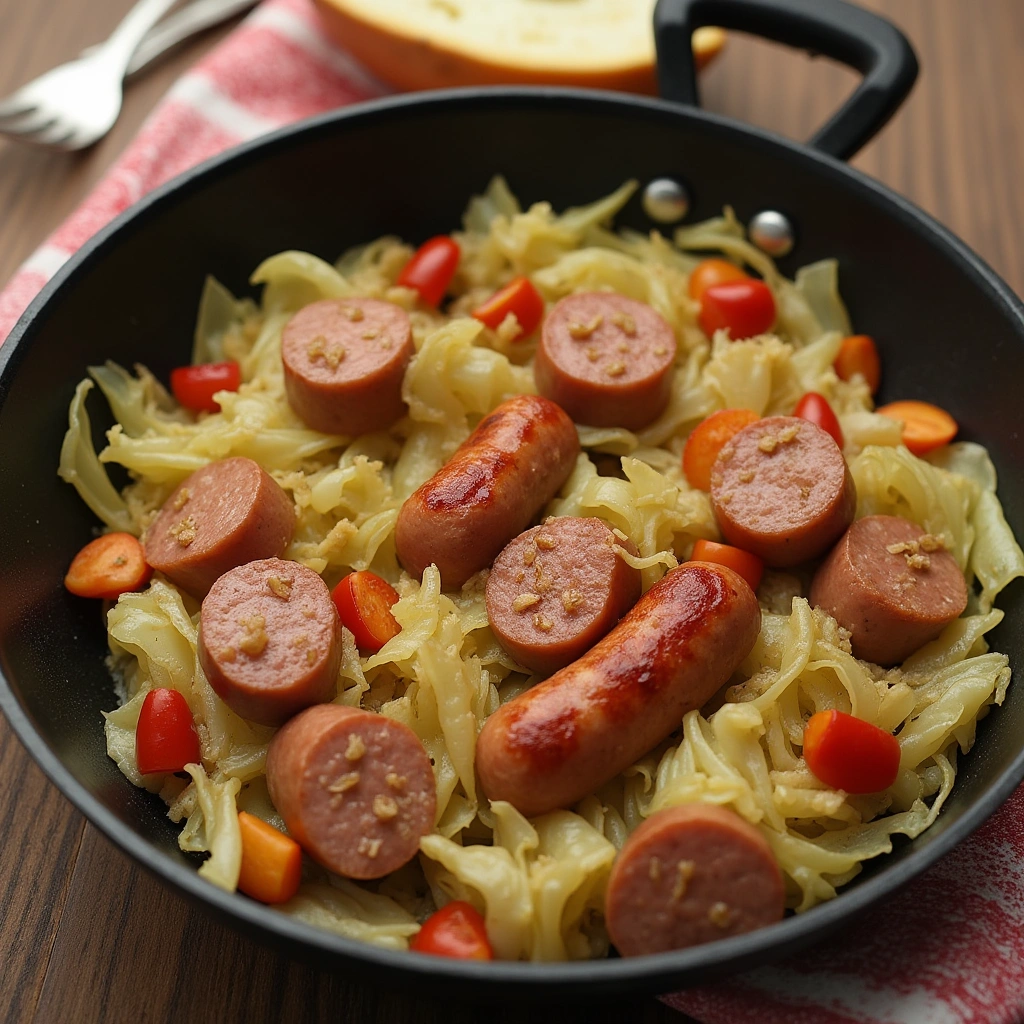
Cooking Techniques
Learning to make a tasty sausage and cabbage dish is all about mastering a few cooking techniques. Let’s explore the steps to turn your ingredients into a mouthwatering sausage skillet meal.
Sautéing the Sausage
Begin by heating a large skillet over medium-high heat. Add a tablespoon of oil and cook the sausage slices until they’re golden and fully cooked, about 5-7 minutes. Stir the sausage now and then to get even browning.
Wilting the Cabbage
After the sausage is done, add the shredded cabbage to the skillet. Cook the cabbage, stirring often, until it wilts and gets tender, about 5-8 minutes. It should still have a bit of crunch but be soft overall.
Combining Ingredients
- Once the sausage and cabbage are cooked, it’s time to mix everything together. Add any seasonings you like, like garlic, onions, or spices, and sauté for 2-3 more minutes.
- Then, add a splash of broth or stock to make a tasty sauce. Let it simmer for 2-3 minutes to blend the flavors.
By using these simple cooking methods, you can make a delicious and cozy sausage skillet meal. It’s perfect for any German sausage dish.
Tips for Enhancing Flavor
Boosting the taste of your sausage and cabbage dish is simple. Choose herbs and spices wisely to elevate it. Adding broth or stock brings depth and richness.
Herbs and Spices to Consider
Try aromatic herbs and warm spices to match the sausage and cabbage’s natural taste. Good choices include:
- Freshly chopped parsley, thyme, or rosemary for a herbal note
- Smoked paprika, fennel seeds, or caraway seeds for a touch of earthy sweetness
- Crushed red pepper flakes or cayenne for a subtle heat
- Whole peppercorns or ground black pepper for a peppery kick
Begin with small amounts of these seasonings. Adjust to your liking. The goal is to highlight the sausage and cabbage’s natural taste while adding a touch of flavor.
Incorporating Broth or Stock
Using a flavorful broth or stock can make your dish better. Choose chicken, beef, or vegetable broth based on your taste. It adds savory notes and a saucy texture.
For a richer taste, deglaze the pan with white wine or apple cider vinegar after cooking the sausage. This captures the browned bits, enhancing the flavors.
“The secret to a truly delicious sausage and cabbage dish lies in the thoughtful use of herbs, spices, and liquids. These elements work together to create a harmonious balance of flavors that will leave your taste buds thoroughly satisfied.”
Time-Saving Variations
For busy weeknights, there are quick ways to make a classic sausage and cabbage dish. You can use one-pot cooking, slow cookers, or Instant Pots. These methods make cooking easier without losing flavor.
One-Pot Cooking
Using a single pot or Dutch oven is a simple way to cook this dish. Brown the sausage first, then add the cabbage and other ingredients. This method saves time and makes cleanup easier, perfect for a quick sausage casserole or one-pot meal.
Slow Cooker Method
The slow cooker is great for a hands-off approach. Just layer the ingredients and let it cook. The slow cooking makes the flavors blend well, creating a tender, tasty dish ready when you need it.
Instant Pot Version
The Instant Pot is perfect for when you’re in a hurry. It cooks the sausage casserole or one-pot meal fast. Its quick cooking makes it ideal for busy weeknights when you want a homemade meal quickly.
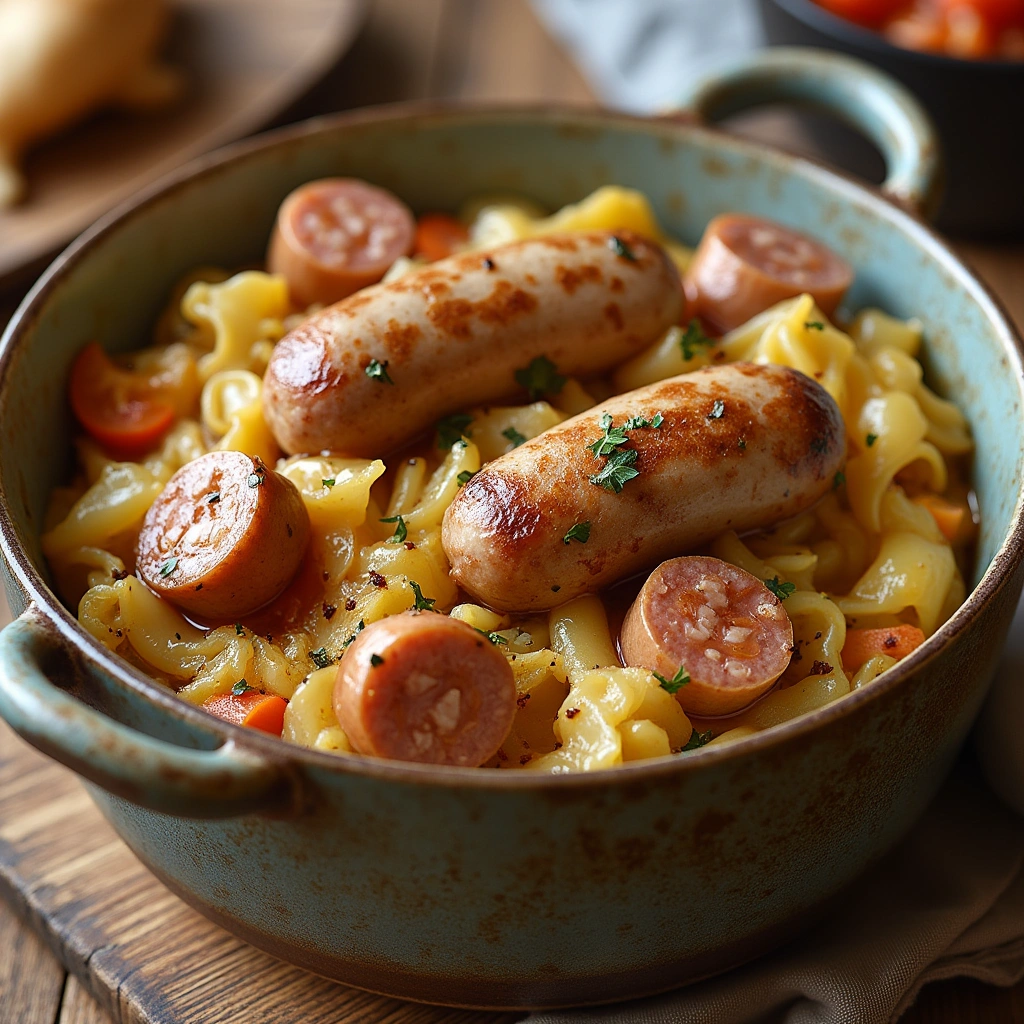
Choosing any of these time-saving methods will get you a delicious meal fast. Try different ways to find what works best for you.
Dietary Adaptations
Sausage and cabbage can be made for many diets. You can make it gluten-free or vegan. This recipe works for everyone.
Gluten-Free Options
For a gluten-free diet, choose gluten-free sausage. Many brands offer sausages without wheat. Just replace the regular sausage with a gluten-free one for a meal everyone can enjoy.
Vegan Alternatives
For a vegan diet, swap sausage for vegan meat substitutes. Soy-based crumbles or plant-based sausages work well. You can also try different vegan cabbage recipes. This way, you can make a vegan version of this classic dish.
These changes make sure everyone can enjoy sausage and cabbage. It’s a comforting meal for all.
Serving Suggestions
Sausage and cabbage is a comforting dish that pairs well with many things. It’s great for rounding out your meal or finding new ways to enjoy it. There are plenty of options to try.
Pairing with Breads
The flavors of sausage and cabbage go well with warm, crusty breads. Here are some good choices:
- Freshly baked dinner rolls or biscuits
- Slices of hearty rye or pumpernickel bread
- Crisp garlic bread or garlic toast
Suggested Side Dishes
For a balanced and satisfying meal, try these side options with your sausage and cabbage:
- Roasted potatoes or mashed potatoes
- Sautéed or steamed green beans
- A simple salad with mixed greens and a light vinaigrette
- Braised red cabbage with apples and caraway seeds
- Buttered egg noodles or boiled new potatoes
These pairings will enhance the flavors of sausage and cabbage. They make for a well-rounded and satisfying meal.
| Bread Pairing | Side Dish Recommendation |
|---|---|
| Dinner Rolls | Roasted Potatoes |
| Rye Bread | Sautéed Green Beans |
| Garlic Toast | Mixed Greens Salad |
| Pumpernickel Bread | Braised Red Cabbage |
| Biscuits | Buttered Egg Noodles |
Pairing your sausage and cabbage with these breads and sides makes a comforting meal. It’s sure to please everyone at the table.
Storing Leftovers
Enjoying a tasty sausage and cabbage dish is just the start. Proper storage and reheating keep your leftovers tasty and fresh. This way, you can enjoy the meal again and again. Let’s look at the best ways to store cooked sausage and cabbage, and how to reheat them.
Best Practices for Storage
To keep your sausage and cabbage leftovers fresh, follow these tips:
- Put the dish in an airtight container within 2 hours of cooking.
- Let leftovers cool completely before storing to stop bacteria growth.
- Cooked sausage and cabbage can stay in the fridge for 3-4 days.
- For longer storage, freeze in a freezer-safe container for up to 3 months.
Reheating Tips
When reheating your sausage and cabbage, use these methods to restore the flavors:
- Stovetop: Warm the leftovers in a skillet over medium heat, stirring often, until hot.
- Microwave: Use a microwave-safe dish, cover loosely, and heat in 1-minute bursts, stirring between each, until hot.
- Oven: Preheat to 350°F (175°C). Put leftovers in an oven-safe dish, cover with foil, and bake for 15-20 minutes, or until hot.
Choose any reheating method, but watch the dish closely. Adjust the time to avoid overcooking or drying out the sausage and cabbage.
By using these easy storage and reheating tips, you can enjoy your sausage and cabbage dish many times. You won’t lose any flavor or texture.
Nutritional Information
Looking into the sausage and cabbage recipe, we see its nutritional value. We’ll explore the calories and health perks of the main ingredients. Cabbage, in particular, is a key player.
Caloric Breakdown
A serving of this dish has about 300 calories. Most of these calories come from the sausage, with 200 per serving. Cabbage, however, is low in calories, with just 50 per cup.
Adding seasonings and optional ingredients can change the calorie count a bit. But overall, this meal is still quite low in calories.
Health Benefits of Ingredients
- Sausage Nutrition: Sausage is a good source of protein. But, it’s best to pick leaner cuts to cut down on saturated fat and sodium.
- Cabbage Health Benefits: Cabbage is packed with vitamins C and K, and fiber. It’s good for digestion and can help reduce inflammation.
This recipe balances sausage with cabbage for a nutritious meal. It’s great for a balanced diet.
“Cabbage is a versatile and nutritious vegetable that can be enjoyed in a variety of dishes, including this comforting sausage and cabbage recipe.”
Final Thoughts on Sausage and Cabbage
Sausage and cabbage is a delightful comfort food dish. It combines the rich flavors of savory sausage with the satisfying crunch of cabbage. This timeless recipe offers a warm and nourishing meal perfect for any time of year.
Embracing Comfort Food
In today’s fast-paced world, it’s key to enjoy simple, traditional meals. The sausage and cabbage recipe reminds us of the joy in home-cooked dishes passed down through generations. It’s a way to slow down and appreciate the love in our food.
Making It Your Own
This recipe is a great starting point, but it’s all about making it your own. Try different sausages, cabbage types, or add your favorite herbs and seasonings. By personalizing it, you create a dish that’s uniquely yours and loved by all.

